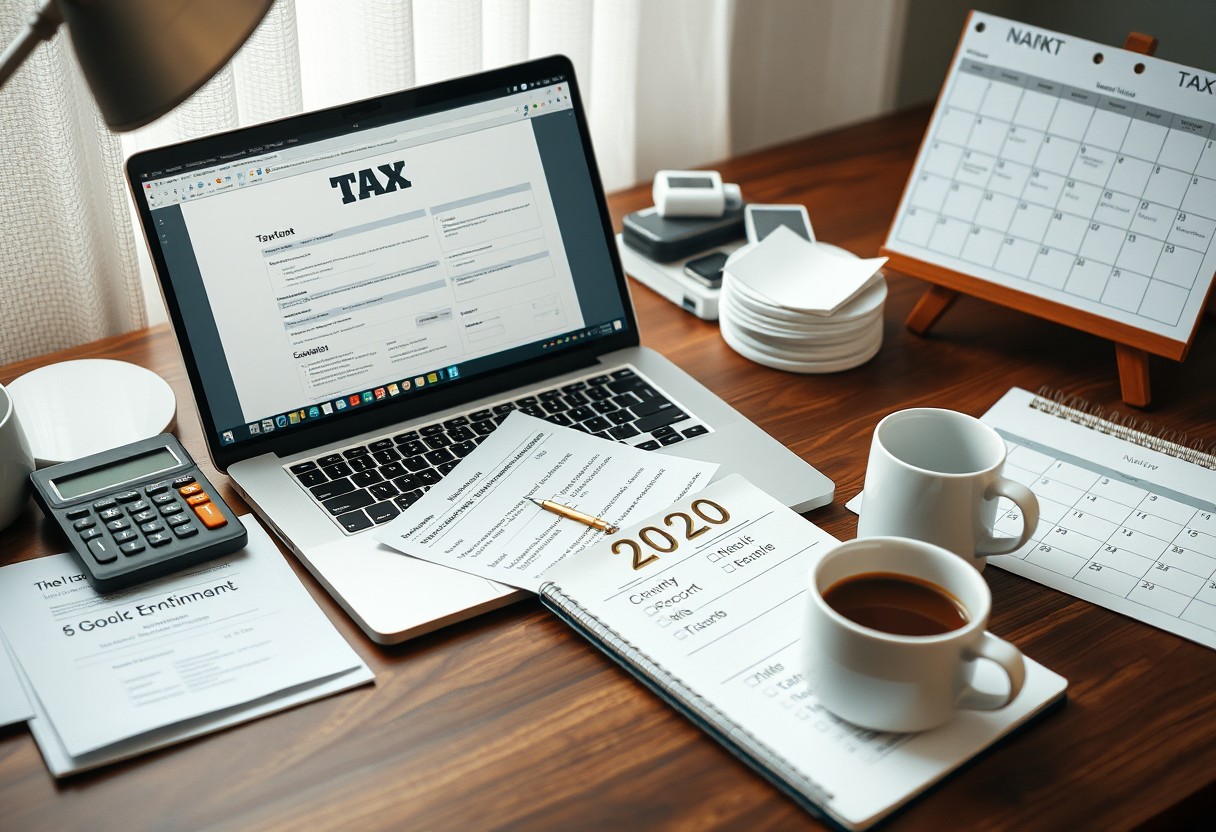How To Prepare For Tax Season – A Step-by-Step Income Tax Checklist
Most individuals dread tax season due to the complexities involved, but with proper preparation, you can ease this burden significantly. This guide provides you with a step-by-step income tax checklist to ensure that you cover all necessary aspects of your taxes. From gathering documents to understanding deductions, you’ll discover how to take control of your financial responsibility and avoid costly mistakes. Follow these actionable tips to streamline your tax filing and possibly maximize your refund, making tax season a smoother experience for you.
Understanding Tax Obligations
Your tax obligations can seem overwhelming, but understanding them is crucial to ensuring compliance and avoiding penalties. Familiarizing yourself with the types of income you need to report, as well as the important deadlines that come with them, will help you prepare effectively for tax season. The IRS requires taxpayers to report various types of income, and staying informed about these can save you from surprises when filing your return.
Types of Income to Report
Types of income include salaries, wages, dividends, interest, and any other sources of income that contribute to your earnings in a tax year. Knowing what qualifies as reportable income is necessary for accurate tax filing. Below is a table summarizing the main types of income you should consider:
| Type of Income | Description |
|---|---|
| Wages and Salaries | Payments from your employer for work performed. |
| Interest Income | Earnings from interest on savings accounts or loans. |
| Dividend Payments | Profits distributed from stocks or mutual funds. |
| Rental Income | Revenue earned from leasing out property. |
| Other Income | Any miscellaneous income not categorized above. |
After identifying your income sources, ensure you collect all relevant documentation, including W-2 forms or 1099s, to support your claims. This preparation will help you report your income accurately and efficiently during tax season.
Important Deadlines
On the path to preparing your taxes, knowing the important deadlines imposed by the IRS ensures you are not caught off guard. Typically, the primary deadline for filing your federal income tax return is April 15th of each year. However, if this date falls on a weekend or holiday, the deadline may shift to the next business day. Keep these deadlines in mind as they are pivotal to avoiding late fees and penalties.
Understanding the deadlines is critical for your tax obligations. Missing these dates could lead to hefty penalties and increased stress as you scramble to compile your tax information and file on time. For instance, if you want to file for an extension, you need to file Form 4868 by the original deadline and pay any estimated taxes due to avoid further penalties. Make sure to mark important dates on your calendar and stay organized, keeping your tax documents and forms ready ahead of time.
Organizing Financial Documents
It is necessary to organize your financial documents meticulously before exploring into tax preparation. Having a systematic approach will not only streamline the filing process but also reduce the risk of missing deductions or important deadlines. Take the time to categorize your documents, separating them into income, deductions, and credits. This preparation will make it easier to ensure you have everything you need when it’s time to fill out your tax return.
Gathering Necessary Forms
If you want to prepare your taxes efficiently, you must start by gathering all necessary forms. This includes W-2s from your employer, 1099s for freelance or contract work, and any other relevant income statements. You may also need tax forms related to investments, rental properties, and other possible income streams. Having these documents in one place will streamline the filing process and minimize the risk of errors.
Tracking Receipts and Expenses
Documents related to your expenses, such as receipts and invoices, play a crucial role in maximizing your potential deductions. Keeping a record of all your business and personal expense receipts enables you to substantiate your claims during tax time. Additionally, ensure you have documentation for any significant deductions, such as charitable donations, medical expenses, or home office costs.
Understanding the importance of tracking your receipts and expenses can’t be overstated. Failing to maintain a meticulous record can lead to missed deductions, which can ultimately affect your tax refund or increase your liability. Utilize tools such as spreadsheets, apps, or accounting software to organize your expenses throughout the year, so you’re not scrambling at the last minute. Remember that accurate records are necessary in the event of an audit, making your diligence all the more critical.
Deductions and Credits
Little do many taxpayers realize that deductions and credits can significantly reduce your tax liability, making it imperative to understand both when preparing for tax season. Deductions lower your taxable income, while credits provide direct reductions in your tax bill. Taking the time to familiarize yourself with the options available to you can lead to savings that directly impact your financial situation. As you gather your documents, be sure to keep an eye out for potential deductions and credits that could benefit you.
Common Deductions to Consider
Credits in the tax world come in various forms, but some of the most common deductions you should consider include expenses related to mortgage interest, medical expenses, and state or local taxes. You might also be eligible for deductions related to student loan interest, education costs, and charitable donations. Make certain that you carefully document these expenses and maintain receipts, as this can prove invaluable if you are ever audited by the IRS. Every dollar counts, and understanding these deductions is the first step toward maximizing your refund or minimizing your overall tax burden.
Eligibility for Tax Credits
Deductions can make a measurable impact on your finances, but eligibility for tax credits can provide you with even more substantial savings. You should familiarize yourself with credits such as the Earned Income Tax Credit (EITC) and the Child Tax Credit, which have specific requirements based on income levels and household composition. By ensuring that you meet the eligibility criteria, you can take full advantage of these potential credit opportunities that the IRS offers. Note that unlike deductions, which reduce your taxable income, tax credits directly decrease the total amount owed, making them incredibly beneficial.
Another important aspect to consider when evaluating your eligibility for tax credits is that credits may phase out or be reduced based on your adjusted gross income (AGI). It’s crucial to keep track of your income throughout the year and understand how different financial decisions may impact your overall AGI, thereby affecting your eligibility for certain credits. Taking the time to assess your standing can save you from unexpected surprises come tax filing time and position you to maximize your savings effectively.
Choosing the Right Filing Method
After gathering all your tax documents, the next crucial step is choosing the right filing method. Your individual financial situation, the complexity of your tax forms, and your comfort level with tax preparation will largely determine whether you opt for DIY tax preparation or hire a professional. Selecting the best approach can save you both time and money while ensuring that you accurately report your income and claim any deductions or credits you’re entitled to.
DIY Tax Preparation
Some taxpayers prefer a DIY approach when filing their taxes, especially when their financial situation is straightforward. If you have a simple income source, such as a single W-2, and few deductions to claim, online tax software can guide you through the filing process. These user-friendly platforms typically provide step-by-step instructions, maximizing deductions while minimizing the risk of errors. Additionally, many may offer free options for basic returns, which can be a cost-effective solution for your tax needs.
However, you should be cautious about engaging in DIY tax preparation if you have multiple income sources, own a business, or have undergone significant life changes, such as marriage or homeownership. In these cases, the nuances of tax law can get complicated, and the margin for error increases significantly. Missing out on credits or incorrectly reporting income could lead to an audit or costly penalties down the line, so it’s vital to be honest about your comfort level and complexity of your situation.
When to Hire a Professional
Preparation for hiring a tax professional can be revealing when evaluating your financial circumstances. If your tax situation involves complexities such as investment income, rental properties, or complicated deductions, it may be wise to engage an expert who can navigate the tax code more efficiently. A certified public accountant (CPA) or tax expert has specialized knowledge that can ensure you take full advantage of the tax laws and avoid costly mistakes.
Plus, hiring a tax professional can provide you with peace of mind during tax season. With their expertise, you can rest assured that your return is filed accurately and on time, reducing the risk of audits or missed deductions significantly. They can also offer strategic advice for tax planning, helping you to optimize your tax strategy not just for the current year but for future tax seasons as well. Ultimately, investing in a professional can save you time, stress, and money—qualities that are often worth the cost when it comes to your financial well-being.

Tax Planning Strategies
Not knowing how to effectively plan for taxes can lead to missed opportunities that may cost you significant sums in the long run. Engaging in strategic tax planning is crucial for optimizing your income and reducing overall tax liability. By understanding various tax planning strategies, including retirement contributions and managing investments, you can navigate tax season with greater ease and confidence.
Retirement Contributions
Contributions to your retirement accounts are not only a way to secure your financial future but also a strategic tax planning tool. By maximizing contributions to accounts like an IRA or 401(k), you can reduce your taxable income for the year. This reduction can lead to lower tax bills and, in some cases, increased refunds, making it a win-win for your financial health.
Managing Investments
For individuals looking to minimize taxes, managing your investments strategically can yield substantial benefits. By carefully selecting which investments to buy and sell, you can take advantage of long-term capital gains rates, which are typically lower than ordinary income tax rates. Additionally, tax-loss harvesting—selling underperforming investments to offset gains—can be a powerful tool to help you reduce your tax burden.
Another crucial aspect of managing investments is to keep your portfolio balanced. Regularly reviewing and rebalancing your investments not only aligns them with your financial goals but also allows you to realize gains strategically. Consider utilizing tax-advantaged accounts for your higher-earning investments, as these can shield you from immediate tax liabilities, providing you with a stronger financial position when tax season rolls around.
Filing Your Taxes
Many taxpayers often find the process of filing their taxes daunting, but with the right preparation, it can be a straightforward task. Completing your tax returns accurately ensures that you receive any due refunds and avoids potential penalties from the IRS. Knowing the ins and outs of tax filing can make a significant difference in your overall experience during tax season.
Step-by-Step Filing Process
With a clear plan in place, you can file your taxes efficiently. Follow this structured approach to make the process smoother:
| Step | Description |
| 1 | Gather Financial Documents: Collect all relevant documents like W-2s, 1099s, and receipts for deductions. |
| 2 | Select the Appropriate Filing Method: Decide whether to e-file or file a paper return based on your comfort level. |
| 3 | Fill Out Your Tax Forms: Using the gathered documents, accurately complete the required tax forms. |
| 4 | Double-Check for Errors: Review your completed forms for any mistakes or missing information. |
| 5 | Submit Your Return: File your taxes by the deadline, ensuring you keep a copy for your records. |
Tips for Avoiding Common Mistakes
You can save time and stress by implementing strategies to prevent common filing errors. Mistakes can lead to delays in processing your return and potential penalties, so you should focus on the following tips:
- Always check for math errors on your forms.
- Ensure that all Social Security numbers are correct.
- Double-check that you’ve claimed all eligible deductions and credits.
- Review your filing status to ensure it reflects your current situation.
Perceiving these steps and guidelines as a checklist can significantly streamline your tax filing experience. By remaining vigilant and methodical, you can minimize errors and optimize your return. If you implement these tips, your filing process can lead to a more positive outcome during tax season.
Common mistakes can easily be avoided with proper attention to detail. Remember that tax filing is serious, and it pays to be thorough. Always ensure that you have documented proof of all income and deductions. Here are some key considerations to keep in mind:
- Keep a detailed record of financial transactions to support your claims.
- File your return as soon as possible to shorten the wait for your refund.
- Stay abreast of any changes to tax laws and regulations that may affect your filing.
- Consider using tax software or hiring a professional if you’re uncertain.
Perceiving these details as vital can help you avoid costly errors and ultimately lead to a successful tax filing experience.
Final Words
Upon reflecting on the importance of preparing for tax season, it becomes clear that having a solid plan and checklist can significantly ease the process. By following the step-by-step income tax checklist outlined, you will not only ensure that you have all your necessary documents at hand but also make the experience less daunting. Do not forget, organization is key to maximizing your deductions and minimizing your liabilities. Make your checklist a living document that you update regularly throughout the year; this will prevent unnecessary last-minute scrambles and allow you to feel more in control when tax season arrives.
Moreover, being proactive about tax preparation not only helps you fulfill your legal obligations but can also lead to financial benefits such as tax credits or refunds. By educating yourself on various tax regulations and regularly revisiting your checklist, you empower yourself to make informed decisions that can positively impact your financial situation. Ultimately, taking the time to prepare thoughtfully for tax season will save you stress and could lead to increased savings, thus allowing you to focus on what matters most in your life.
Q: What documents do I need to gather to prepare for tax season?
A: To prepare for tax season, you’ll need to gather several important documents, including:
– W-2 forms from your employers, which report your annual income.
– 1099 forms for any freelance work, interest, dividends, or other income received.
– Documentation for any additional income including rental income, state tax refunds, or unemployment benefits.
– Receipts for deductible expenses such as medical costs, mortgage interest, property taxes, and charitable contributions.
– Investment statements and records of any capital gains or losses.
– Your prior year’s tax return for reference and to help transfer information if you are using tax software.
– Any relevant documentation for education expenses, like 1098-T forms for tuition payments.
Organizing these documents beforehand will streamline your tax filing process.
Q: What deductions and credits should I be aware of while preparing my taxes?
A: Being aware of various deductions and credits can significantly reduce your taxable income. Key deductions to consider include:
– The standard deduction, which varies based on your filing status (single, married, etc.).
– Itemized deductions for mortgage interest, state and local taxes, and charitable contributions if they surpass the standard deduction amount.
– Student loan interest deduction up to a certain income level, as well as education credits like the American Opportunity Credit or Lifetime Learning Credit for eligible expenses.
– Retirement account contributions, such as those to a Traditional IRA or 401(k), may also offer tax benefits.
It’s crucial to review the eligibility criteria for each deduction or credit to maximize your savings during tax season.
Q: How can I stay organized throughout the tax filing process?
A: Staying organized is crucial for a smooth tax filing experience. Here are some steps you can take:
– Create a dedicated folder (physically or digitally) to store all your tax-related documents as you gather them. This can include receipts, forms, and correspondence.
– Use a checklist to track each item you need to file your taxes. This ensures you won’t overlook anything important.
– Set deadlines for yourself leading up to tax day to complete various steps, such as gathering documents, inputting data into tax software, or scheduling a meeting with a tax professional if you need assistance.
– Consider using tax software that allows you to easily import documents and store data securely. Some programs even provide reminders and tips throughout the process.
By establishing a systematic approach, you can reduce stress and ensure you have everything you need when it’s time to file your taxes.
![]()













